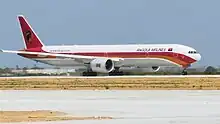Dr. Antonio Agostinho Neto International Airport | |||||||||||||||
|---|---|---|---|---|---|---|---|---|---|---|---|---|---|---|---|
 | |||||||||||||||
| Summary | |||||||||||||||
| Airport type | Public | ||||||||||||||
| Owner | Government of Angola | ||||||||||||||
| Operator | Empresa Nacional de Exploração de Aeroportos e Navegação Aérea (ENANA) | ||||||||||||||
| Serves | Luanda | ||||||||||||||
| Location | Bom Jesus, municipality of Ícolo e Bengo, Luanda Province, Angola | ||||||||||||||
| Hub for | TAAG Angola Airlines | ||||||||||||||
| Elevation AMSL | 522 ft / 159 m | ||||||||||||||
| Coordinates | 9°2′48.4″S 13°30′25.9″E / 9.046778°S 13.507194°E | ||||||||||||||
| Website | enana.co.ao | ||||||||||||||
| Runways | |||||||||||||||
| |||||||||||||||
Source: aerobaticsweb.org [1] | |||||||||||||||
Dr. Antonio Agostinho Neto International Airport (Portuguese: Aeroporto Internacional Dr. António Agostinho Neto)[2] (IATA: none, ICAO: FNBJ), informally Novo Aeroporto Internacional de Luanda (NAIL), is an international airport which currently only operates cargo flights, serving the capital of Angola, Luanda. It is located in Bom Jesus, municipality of Ícolo e Bengo, Luanda Province, Angola 40 km south-east of the city center. It will replace the city's existing Quatro de Fevereiro Airport. The lead construction company is China International Fund, which was founded in Hong Kong in 2003.[3] The company built a village named Vila Chinesa, meaning "Chinese village" in Portuguese, for the accommodation of workers and material depots.[4] Along with some Chinese contractors, the Brazilian company, Odebrecht, are constructing the airport.
The airport opening has been delayed several times due to financial difficulties faced by the Angolan government, along with similar issues also faced by the two companies building the airport. These problems forced the originally scheduled date for completion in 2012 to be postponed to 2015, and then again to 2017. It was later stated in the media that the facility would be ready to start operations around late 2022, but due to delays caused by corrections needed in the main terminal building and the COVID-19 pandemic, the opening was delayed until 2023. The airport has been regarded by many as the biggest "white elephant" in Africa for the past decade. It is the biggest airport being built from scratch in Africa during the 21st century.
The airport was officially inaugurated on November 10, 2023, initially starting with cargo operations.[5] Domestic passenger flights are planned to begin in March 2024, and all international passenger services are expected to use the new airport by mid-July 2024.
Angola's Minister of Transport, Ricardo Viegas D'Abreu, said "we intend to create an international civil aviation hub in Luanda, which will play a crucial role in connecting Africa and the other continents."[5] The five busiest airports in Africa handle 7.5 to 28 million passengers per year,[6] of which three have direct flights from Luanda. The older Luanda airport served 5.6 million in 2018.
Facilities
The airport is expected to have the capacity to serve 15 million passengers per year initially.


The passenger terminal occupies 160,000 sq.m, while the cargo terminal is 6,200 sq.m., with an annual capacity of 35,000 tonnes of cargo. The airport's site was finalised in 2004, and construction began in mid-2006. The construction costs, which are financed entirely by China, and were estimated at US$3,8 billion (2015).[7] Complementary infrastructure, such as shops, hangars, restaurants, offices and a nearby hotel are not included. The airport's total area is 50 sq.km.
The project includes the construction of a rail link to the capital, to the province of Luanda and possibly to the neighboring province of Malanje. Due to high traffic jams and in order to cope with the future traffic, the highway connection to Luanda required that the existing road from Luanda to Malanje needs a mass expansion, which is now completed, and is converted as a six-lane and four-lane highway.
Runways
The airport has two parallel runways, located 2.2 kilometres (1.3 mi) from each other, which are designed for simultaneous take-offs and landings. The first runway is 4,000 m × 60 m (13,123 ft × 200 ft) and is set to be used as the main runway for take-offs and cargo operations. The second runway is 3,800 m × 60 m (12,467 ft × 200 ft).
Airlines and destinations
Passenger

The following airlines are set to operate regular scheduled and charter flights to and from the new airport once operations are transferred from the Quatro de Fevereiro Airport:
References
- ↑ "Airports Report Luanda". aerobaticsweb.org. Retrieved 9 March 2015.
- ↑ Angolan transport minister about naming of the airport, portalangop.co.ao, retrieved 8 March 2015
- ↑ "Angola Delays Opening of $5 Billion Airport for the Fourth Time". Bloomberg.com. 17 June 2022. Retrieved 4 December 2022.
- ↑ Google Maps
- 1 2 Tatenda (10 November 2023). "Angola Opens New $3 Billion Luanda International Airport". Simple Flying. Retrieved 6 January 2024.
- ↑ "List of the top 5 African airports in 2024". kiwi.com. Retrieved 6 January 2024.
- ↑ (in Portuguese) Novo aeroporto de Luanda deverá ser o “mais importante” na África Central, VerAngola from 5 March 2015
External links
- Homepage China International Fund Limited (en)
- First images published of new Luanda Airport 28 March 2009
- Report Angonoticias (pt)
- Angola Acontece (pt)
- Minister: New Airport works delayed 15. November 2007
- Angola International Airport Google Maps, March 2013